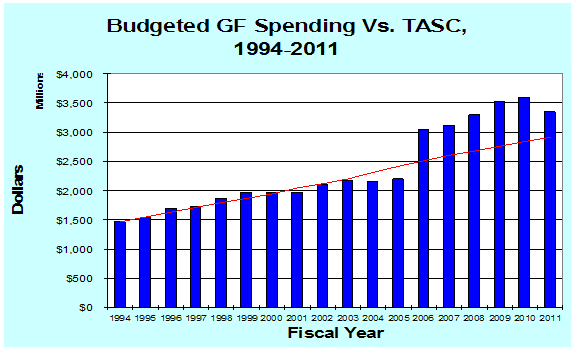About that TASC amendment
Tax and Spending Control could have averted fiscal crisis
- Monday, February 8, 2010
Remember when Tax and Spending Control (TASC), a proposed constitutional amendment intended to limit the growth in state spending to inflation plus population growth, was mocked and ridiculed? The aim of TASC and similar provisions in other states is to prevent significant increases in inflation-adjusted, per-capita government spending without voter approval. That goal would seem particularly relevant now that those spending increases have led Nevada headlong into a fiscal crisis.
It seems hindsight is 20/20.
A TASC-like amendment could have stopped Nevada's fiscal woes before they even began. Had such a provision been in place since the mid-1990s, inflation-adjusted, per-person spending would never have jumped by $291 in FY06 and it certainly would not have remained at such an elevated level over the next six years.
A line drawn from the mid-1990s, on the chart below, makes it painfully obvious that today's fiscal crisis resulted directly from the absence of spending caps. Budgeted spending for the fiscal years between FY06 and FY11 exceeded such a level by a combined $3.64 billion. In fact, spending in the 2009-2011 biennium, a cycle that has been derided by some lawmakers for spending "cuts," would have been limited to $5.75 billion if TASC-like constraints existed. The $6.95 billion budget passed for this cycle entailed the $1 billion in tax increases that the 2009 legislature imposed on Nevadans.

If the 2011 legislature makes those tax increases permanent (as legislative leadership, no doubt, intends to do), you should expect to see another jump in state spending similar to what happened in FY06 once the economy recovers. That is the characteristic feature of Nevada's tax-and-spend cycle: periodic and lingering jumps above the old per-person spending levels.
In fact, if lawmakers on the Interim Finance Committee get the new tax on small businesses they want, the next jump in spending could be even more pronounced than that of FY06. At a time when legislators already have difficulty funding the programs they've created over the past several years, the IFC is driving to fund a bevy of new government programs. IFC lawmakers have appointed a new "stakeholder group" composed primarily of tax-dollar recipients to "envision" even more new ways for lawmakers to spend money.
It is now clear why big-spending lawmakers have consistently and vehemently argued against constraints on spending controls. It is equally clear why such controls are needed. Despite claims to the contrary, TASC-like controls would not hamstring the ability of lawmakers to respond to the state's most urgent needs. Under such a provision, lawmakers are free to reassign state resources from one area of spending to a higher-priority area as the needs of the state change. It also allows for increases in inflation-adjusted, per-person spending when such increases are approved by the general electorate.
Indeed, the primary function of a TASC-like amendment is not to handcuff the responsiveness of state government, but to give control over the state's most important decisions back to the people.
Given the experience of recent history and the revenue dynamics now occurring in the state legislature, it is clear that Nevada taxpayers need the protection offered by TASC-like spending constraints now more than ever.
Geoffrey Lawrence is a fiscal policy analyst at the Nevada Policy Research Institute. This commentary first appeared in the February 2010 edition of Nevada Business.





